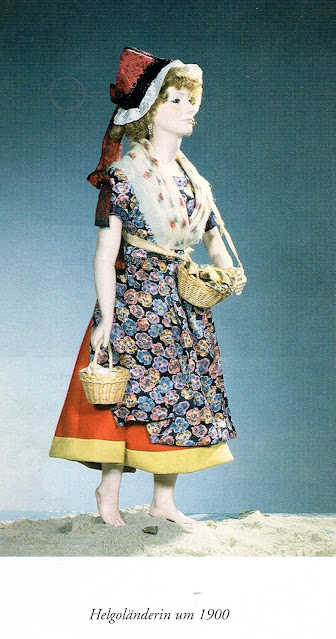Hello all,
Today I want to talk about the folk costume of the island of Helgoland, also called Heligoland in English. The natives of the island call it deät Lun -'the Land'. This island lies in the North Sea, about 40 miles north of the coast of Germany. The island has in recent history been the possession of Denmark, the United Kingdom, and most recently, Germany. The inhabitants of the island are, however, Frisian, and famously have rejected the languages of all three of their occupiers, preferring their own North Frisian dialect of Halundur. There are actually two islands, which were connected until 1720, in total having an area of 1.7 km sq. There is only one town on the island, with between 1 and 2 thousand inhabitants.
https://en.wikipedia.org/wiki/Heligoland
The flag and symbol of the island is three horizontal stripes of green, red, and white.
The history of this costume has been surprisingly well documented. I will present the costume as worn today.
The foundation layers are not visible when fully dressed, consisting of a chemise and underskirt. In the past, multiple skirts were worn, as in many places. The outer skirt, paik, today is red, with a yellow band on the hem.
The apron is very long and full, covering the front of the skirt, It is made of a colorful print material.
The blouse, bluse, is today made of cloth matching the apron. It is generally short sleeved, with a band of lace at the ends of the short sleeves. This lace would originally have been on the chemise underneath.
Before WWII, the blouse was usually made of a contrasting material. Fine silk and embroidery were used.
One distinctive feature of the bluse is a sort of bustle, or rear peplum, made of seven box pleats, to represent the seven seas.
A small shoulder shawl is part of the current costume, originally tucked into the neckline, then wrapped around the shoulders with the point in back, but today often worn with the point hanging in front.
The front of the shawl is pinned in place with the 'hartjen'. A silver brooch in the shape of a heart, with various symbols in silver attached, traditionally a ship, a rose branch, an angel, and a lotsenzeichen, or 'pilot's badge'.
The current headdress is a cap, hülnduk. It is made of fine colorful cloth with ribbons around the edge and along the center line, possibly with embroidery added, trimmed with lace, and with a bow attached behind. The hair should be put up underneath, but today the women often do not bother.

The men generally wear fisherman's outfits, with slops or pants, smocks, a sort of tam with a checkered band, or even slicker hats. Here are some examples from different time periods.
Just a few more images of this costume.
Here is a video of the local dance group performing.
https://youtube.com/shorts/LZ7-yFT8tMI?si=YOX4yhHe2glu3rAx
Thank you for reading, I hope that you have found this to be interesting and informative.
Roman K.
email: rkozakand@aol.com
Source Material:
https://www.helgoland.de/wissenswertes/sitten-und-braeuche-2/trachten/
Ruth Kreutzkam, 'Helgoländer Trachten', Helgoland, 1994
Uwe Karsten, 'Deutsche Trachten', Vienna, 1980
Debionne / Meissner, 'Die Schonsten Deutschen Trachten', Munich, 1987

.png)
.png)
.svg%20-%20Copy.png)
















































No comments:
Post a Comment